by Stephen Bernasconi
In a world in which so much can be ordered at the click of a mouse online, it is sometimes difficult to fathom just what it might mean to go an entire decade without being able to shop! Yes, shop for things you need, of course. But also, and especially, things you may covet; something you dream about. Oh, and then, after what must seem like such a long time of frugality and thrift, you are almost hopeful that good times will come back and, WHAM! You are called up for military service or asked to work as many hours as possible to help win a World War for your country.
This scenario unfolded for the group of Americans Tom Brokaw would come to name, “The Greatest Generation.” After 15 years of pinching and saving through the aftermath of the Great Depression and a goods-starved war, the 1950s arrived and consumers were more than ready for a “product party.” And party they did.
While there have been many examples throughout design history of ostentation, heavy embellishment, and excess, few can rival the “Fabulous Fifties.” With money saved during the war, consumers let loose with a buying spree to end all others.
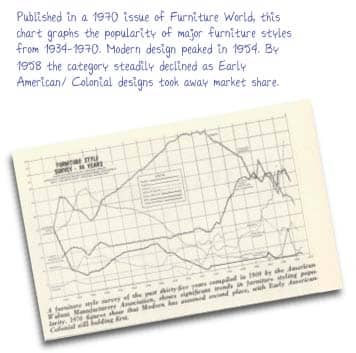
Americans found themselves in a nation whose factories had been brought out of mothballs and whose cities remained untouched by the war’s bombing raids. Raw material shortages subsided as businesses that had converted to war production raced to retrofit for peacetime consumers starving for new products.
Initially, many companies ranging from home furnishings to automotive rushed out new products based on the last designs offered before the war. Given that the war in the Pacific had been expected to last much longer, most companies had little time to prepare for business during peacetime. And customers were certainly eager to purchase whatever new products were on the market.
1950s TECHNOLOGY
This decade saw many advances unleashed that began with technology. The push for synthetic replacements for materials such as rubber (Neoprene) and silk (Nylon) revolutionized design in the home once the war ended. These changes showed up in everything from upholstery fabrics to carpeting, allowing designers to embrace design elements such as metallic threads on a greater scale than before. When Elvis stepped out in his now iconic gold lamé suit, it was wartime research that, in part, made this possible. The same was true for water-based paints for interiors that eventually supplanted the dominance of oil-based finishes. The decade of the 1970s would later become known for furniture made almost entirely from plastics, but excitement for new synthetic fabrics and materials started to build in the ‘50s. Being easy to clean, these modern materials fit well with modern furniture design as well as the ethos of a new, more casual and comfortable lifestyle. “The amazing improvements that have already taken place,” noted an editorial piece in an October 1954 issue of Furniture World, “have occurred in the astonishingly short space of less than ten years. Before World War II, nylon stockings were the only textile articles obtainable with such revolutionary properties as super-quick drying and perfect shape retention. Today, nylon and newer members of Du Pont's test-tube group have simplified the maintenance of many different types of clothing and home furnishings, and have brought more varied and longer-lasting fabrics.
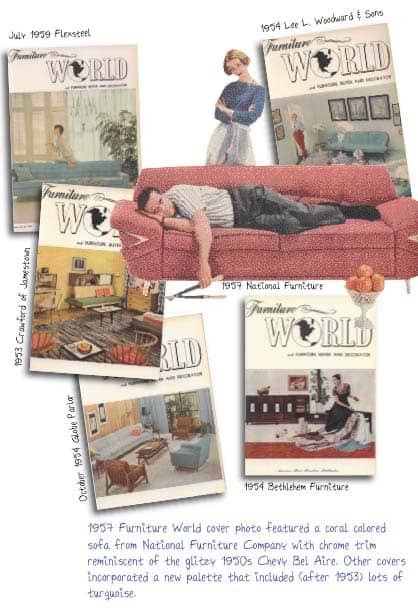
“Compared with natural fibers, nylon, ‘Orion,’ and ‘Dacron’ are all superior in strength, shape retention, wrinkle-resistance, easy washing, rapid drying, and reduction of ironing. Moths have no appetite for them and mildew causes no damage to these fibers. They can provide coolness or warmth, depending on fabric construction.
DESIGN INFLUENCES
Today, we call the major furniture style of the ‘50s Mid Century Modern or, sometimes, just “Mid Century.” Following World War II, Modernism and Minimalism would grow in influence in both architecture and product design to eventually become accepted by the popular culture.
The furniture buying public was ready to break away from the more formal designs of the pre-war period and embrace what was considered a more casual and authentic American adaptation of Scandinavian Modern styles introduced before WW2.
“Particularly since the World War,” Commented Robert Monroe, Design Co-coordinator, Grand Rapids Furniture Makers Guild in a February 1950 issue, “we see appearing throughout the United States, home architecture and home furnishings of a definite style trend, which meets the personal needs of the buying public… We have reached a new height in a gracious and casual type of living which might be termed ‘informal.’ In the home, Americans demand comfort, style, color - a place to entertain and to relax - a place for all around ‘gracious living.’
“Logically enough,” he continued, “furniture used today, both upholstered and case goods pieces, has followed a related trend with our contemporary freedom in living. American women, the world's best-dressed women, are quick to transfer their skill in dress to the decorating and furnishing of their homes. No longer is the ‘awakened’ customer interested in the use of camouflage materials and superficial trimmings to disguise the design of her upholstered furniture.”
The decade of the 1950s witnessed the start of the “space race,” following the surprise launch of two Russian Sputnick satellites in 1957. Space-age looking dashboards, electronics, clothing fashion, and textiles followed, incorporating hard edges and the liberal use of metallics. This style influence could be seen in 1955 with the Henredon and Heritage launch of a line of furniture designed by none other than Frank Lloyd Wright. With simple lines and little adornment, the modern aesthetic would expand quickly throughout the industry with product introductions such as Declaration by Drexel with its oiled walnut and slim Scandinavian lines.
Despite social inequities that would come to the forefront in the next decade, Americans as a whole were self-satisfied. The War had been won, and the US emerged as a major power. Soldiers returned home to a generous GI bill. There was a marriage boom, a baby boom, a construction boom and an expanding economy that followed years of material shortages. Interest in the ‘new’ modern styles was high. Home furnishings newspapers and home magazines spread the word.
Henry Foscue, then President of Globe Parlor, wrote in a December 1953 issue of Furniture World that, “in 1934 there were only four national consumer household publications in this country with a total of less than four million subscribers. There are at present twelve shelter and general books for the home-maker, with a total subscription of twenty-six and one quarter million. Think of it - each month these millions of women are paying out cold cash for what amounts to a postgraduate education in the art of home making. Each month they are getting the most practical and glamorous stories and pictures about the biggest and most exciting business in the world - the business of home making - and they love it.
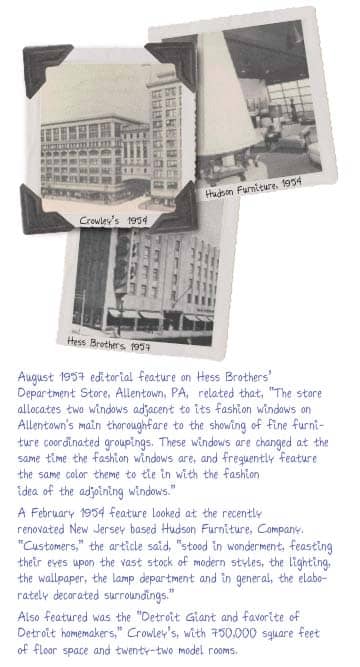
“Thus, there are many factors which augur well for the future of the furniture business. Residential building continues at a rapid rate. Our population has increased by almost 20 million in the last decade.”
Martin Fineman, described as a foremost leader in the modern furniture field in an April 1952 issue, described this change in the following way. “Today contemporary or modern furniture is designed to function in, and enhance the beauty of, the average American home and more than 60 per cent of all the furniture sold in this country is modern. This is in great contrast to the situation of 1926. Then the word was 'moderne' with the implication of faddism, Europeanism, and for the very rich only. We sold to the so-called international set. The ranch-type house was yet to reach the drawing board, as was the living-dining area. The concept of the servant-less house and of plastics, plywood and foam rubber for simpler design forms, was unheard of. All this has changed. In 1952 contemporary design is considered good design only if it serves our way of living better and this means not only in comfort, but also in style and in beautiful interior.”
Department stores were on the leading edge of this trend, creating model rooms and targeting groups like “young marrieds” with reasonably priced, tastefully designed furniture. A 1951 Furniture World Article described the following retail programs:
•At McCreery's, the decorating staff of the furniture department, tying in with the other home furnishing floors, works out programs for home planning from floor plans up, at no charge for its customers. They feel they have especially adaptable furniture for young marrieds in their "Modern America" groupings from Manuel Martin of California, smartly-designed and reasonably-priced pieces in modern lines as inspired by Early American… McCreery's has on display a model apartment setting of four rooms.
- B. Altman and Co., whose "Young Homemakers Shop" had its original conceptions some eight or nine years ago. This store is often credited with starting the trend toward planning for young couples on a budget. 18th Century traditional retains its popularity. Many young Altman marrieds having been brought up with this type of furniture. However, there is considerable demand for modern also and shortly some modern groupings will be especially styled for the young homemaker at Altman's. A five-room Young Homemaker unit has been handsomely decorated by the Altman staff. Color and its many uses is always in the fore at this store, and in these rooms it is most harmoniously used. A color consultant is always ready to help young marrieds along this line. Coordination of furniture and fabrics is also a strong point.
- "Good old Gimbels" carries on a lively trade in all price brackets of home furnishings. "Nobody but nobody undersells Gimbels" is their claim, and many young marrieds are happily surprised to find decorating services available on even the lowest-cost purchasing level. Styling as well as price is a primary consideration of the Gimbel decorators, and a four and one-half room model apartment the store recently set-up in the Young America Modern department amply demonstrates this. Colorful, comfortable, and chic, this apartment can be furnished with furniture costing less than $2,000 and fully, with rugs and accessories, for under $3,000.
COLORS OF THE DECADE
Alongside trending styles like Modern, a lot of traditional furniture styles such as Early American and French Provincial remained popular. How might manufacturers and retailers sell older styles in this new decade of pizzazz? Why with COLOR of course.
To understand the color palette from this era is to really contemplate the mindset of the period. Gone were the muted and somber palettes from the thirties and forties. The need to celebrate product and design again would be reflected in the cheerful and largely pastel like colors that would grace everything from clothing to packaging.
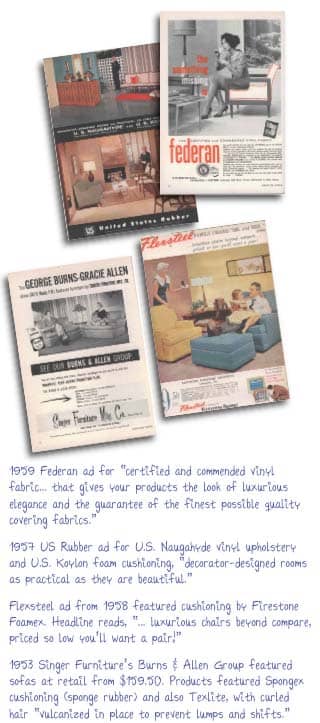
Trends at Chicago’s Merchandise Mart January 1954 show, were previewed in a December 1954 Furniture World article, forecasting that, “Color will be a predominate trend in both modern and traditional furniture. There will be color-rubbed or painted case pieces in such shades as pink, blue, and even bright colors; color combinations like pink with charcoal, or turquoise with white; metal, leather and plastics in high fashion colors; and gold and silver threaded upholstery fabrics in warm or bright shades. Even mattresses will have metallic covers. Super-sized mattresses will be widely promoted. More leather than ever will be used on furniture—even on the legs and supports of tables in one group. Convenience, convertibility and high style at a good price will be stressed throughout furniture showings.”
The beginning of the decade did not look like this of course. Samples of paint and upholstery palettes from the start of the 1950s show a renewed interest in color as palettes slowly began to brighten. As the ‘40s were coming to a close, research on a new synthetic pigment for turquoise was expanded and production ready versions were tested. Once launched, turquoise would be one of the most influential colors of the decade and would continue in some form into the ‘60s. This could be seen as late as 1964 when Flexsteel showed some of its pieces in a very blue version of Turquoise in their upholstery options. Other iconic colors of the period included pink, a yellow based pink called Coral, as well as bright versions of red and yellow.
Gray and black were often used as neutrals to balance these bright tones. It was not uncommon for many products to sport two-tone and even three-tone color schemes. Embellishment levels with color and metallic finishes saw no end in sight as autos, handbags, radios and other merchandise were enhanced with layer upon layer of ornament, sometimes even obscuring the original object. The counterweight to all of this “Bling” as we would call it today was the minimalist forms which furniture would take. As the nation entered 1959, the optimism of chrome and flash would reach its zenith with the dizzying height of the tail fins on GM’s Cadillacs. Not only had the country gone on a buying binge especially during the post WW2 years, design itself reflected the renewed vigor and hopeful outlook for consumers that had gone so long with so little.
THE SIXTIES - KICKING IT UP A NOTCH
In spite of a recession in 1958, American prosperity continued its march upward. Many of the WW II generation were now in their highest earning years. The notion of staying put in one home all of one’s life began to change as consumers became more mobile. The Space race would push technology even further as the cold war would, like WW II before it, spur new innovation in materials and production. In the home furnishings area, this would be revealed with an increasing use of plastics in modern furniture. Synthetic polymer innovation, first begun during the war, showed up in many upholstery fabrics including acrylics and polyesters. Along with the use of urethane foams replacing coir and cotton batting, the petroleum makeup of furnishing materials would grow into what we would today call, the carbon footprint. The metallic use from the prior decade continued with brass accents and metallic fibers increasing their presence. Color, which had shown up in the fifties as bright and cheerful, would move into the most acidic and psychedelic collection the design world has ever seen, even to this day. This comes as no surprise given the great cultural shifts that occurred. When looked at over these two decades, color would be at its most intense and brightest for the longest period. Not until the seventies did the design palette finally return to a neutral basis with the appearance of earth tones.
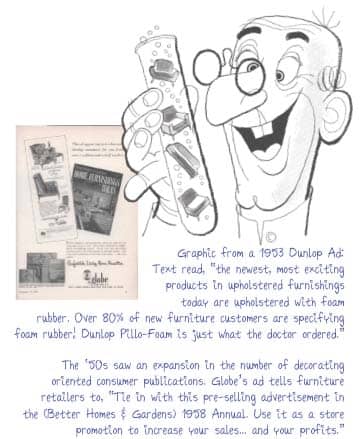
MAKING SENSE OF STYLES & TRENDS
When we look back at design trend history and ask why things happened the way they did, it’s important to note some observations about historical trends generally and about consumers in particular. When forecasting professionals look at trend cycles, they often find patterns over the decades that say a great deal about how consumers see themselves and the world at any given time. For example, if you go back over a century, there have been many boom and bust cycles. The Victorians were the first generation of middle class consumers for which a plethora of refined furnishings and other consumables could affordably be purchased due to newly adopted mechanized production methods. Whether it was a settee or a Model T, the public could purchase items at lower cost than ever before. So, it followed that people gulped down design with not a square inch of space left unadorned.
And let’s not forget another decade before the ‘50s. The Roaring Twenties were not called roaring for nothing. A booming economy following a horribly costly war and new financing tools such as buying on term (credit) would result in yet another boom time for consumers and the objects of their affection. It’s worth noting here that metallics and other flashy design elements made a huge appearance in the thirties, just as they would again in the Fab Fifties.
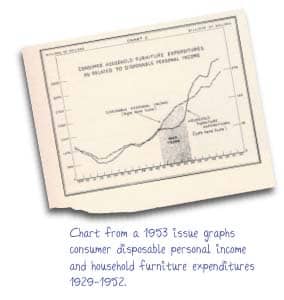
BOTTOM LINE
Consumers have been influenced by design and color trends since ancient times. The desire to have the latest product, technology, or precious material is nothing new. And patterns of quiet vs. flashy design can be seen repeating over the decades.
These patterns largely follow the currents of economy, war, and overall tech development. All of these factors are interwoven of course. War-time restricted consumer interest, yet spawned technology that would spur massive product market growth during peacetime. This impact can be seen today as well. The simplicity message of today following the recent economic downturn is yet another version of the grayed palette seen during the 1930s. Yet, each time-period offers its own unique challenges and twists. What makes each time, including today, unique, are the individual drivers of change. Our current “revolution” is not industrial, but information based. The fact that a consumer in rural Iowa can view live fashion runways anywhere in the world has drastically altered the design landscape yet again.
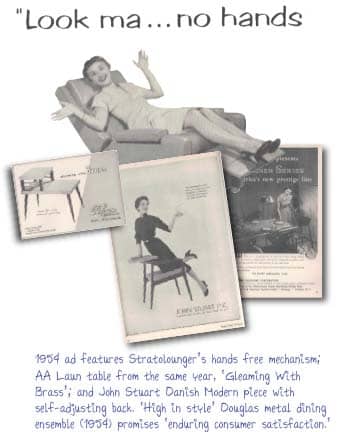
If you are a retailer and wonder if future consumers will cling steadfastly to tradition or go for the latest avant-garde looks, keep in mind that there are consumers for each. Timing of course, is everything. Had Turquoise been ready in 1932, it’s unlikely it would have been the massive hit it was 20 yrs later. It’s the confluence of both technology development AND the timing of consumer appetite that creates truly successful product and trend marketing. Watch the savings rate for consumers currently and as their confidence returns and sentiment becomes less fearful, the timing may be right for that new fangled design. A good historic rule of thumb for trend salability is this: During hard times, tradition, simple, classic, and high value have always sold whether we are speaking of cars or cabinets. When the boom times come, newer styles are more saleable as consumers have increased confidence and are more open to change. Those companies that invest in product development and are ready when trend conscious consumers return, will reap the benefits. This brings up the adage, “The more things change, the more they stay the same.”
Stephen Bernasconi is an accomplished trend analyst in emerging color and design trends. He has been a featured speaker and panelist at numerous trade shows and seminars including the High Point Furniture Market, IDS in Toronto, Design Week in Atlanta, and Designer Week in San Juan PR. He is a published consultant with an extensive background in national and international trend tracking. He is available for special projects as well as speaking engagements and workshops. He can be reached care of Furniture World at sbernasconi@furninfo.com, via his website: www.colorandtrend.com or by phone at 904-315-1219.
EXCERPTS FROM FURNITURE WORLD 1950s ISSUES
What Are The Main Factors Responsible For This Golden Period In The Furniture Industry?
Henry Foscue, President of Globe Parlor Furniture Company, wrote about the state of the industry in a December 1953 issue. He reported that, “there are over 4,000 manufacturers of wood household and upholstered furniture. This compares with 2,250 in 1939. More than three-fourths of these establishments employ less than fifty workers,” He further observed that, “The South leads all other areas in the production of furniture, accounting for 61 per cent of the bedroom and 50 per cent of the dining room. North Carolina outranks all other states in the production of wood household furniture and is second only to New York in the production of upholstered furniture. That state alone produces 24 per cent of the bedroom and 28 per cent of the dining room furniture made in America. “Thus, by examining the chart,” he continued, “you will see that the furniture business has had almost a decade and a half of unbroken prosperity... What then were the main factors responsible for this golden period in the Furniture Industry? We had the scare buying of the second world war, the accumulated demand following the war, the greatest building boom in our history, and then another spree of war scare buying and the Moscow-made boom, all aided and abetted by a social revolution which has seen the birth of a great Laborite market with its
millions of new customers.”
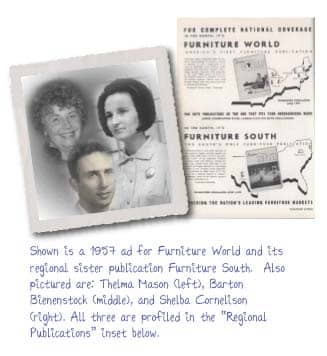
FURNITURE WORLD/ FURNITURE SOUTH Regional Publications - Outstanding People
In the 1950s, many furniture manufacturers targeted their ads regionally to northern states using Furniture World, and to southern states through its sister publication, Furniture South.
Thelma Mason, Furniture World’s Vice President, was hired in 1954 to sell
advertising space in six New England States. Her clients included such famous
furniture names as Temple Stuart, Heywood-Wakefield, S. Bent, Sprague and Carleton, Thomas P. Beals and Nichols and Stone.
In the late 1960s when Canadian furniture manufactures began selling in the US, her territory expanded to include Ontario and Quebec as well as the United Kingdom.
Throughout much of this time period, she provided editorial coverage of the New England trading area, including insightful reports from the Boston show, plus “New England Spotlights,” news on important happenings in furniture manufacturing and retailing. Her persistence and integrity earned the loyalty of three generations of Furniture World advertisers.
Shelba Cornelison, who consulted with Furniture World staff in putting together this 140th anniversary issue, joined the staff of Furniture South 1959. An award winning editor, she directed operations of the High Point office located on the first floor of the IHFC Building for 22 years. Shelba left the publication in 1981, starting a second career with shelter publication Southern Accents.
Barton Bienenstock, Furniture World’s Publisher joined the company in 1956. He guided the publication through good and tough times, the consummate friend, salesperson and industry insider. Thanks Barton!
CLICK HERE to see FURNITURE WORLD Magazine's entire 140th year anniversary issue in "Flip Page" format.